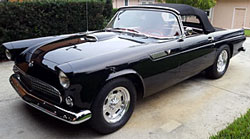I took my TBird out for a drive today and got on it pretty good. It was running great. On the way back to the house it started missing. I thought it was running out of gas. I made it back over 5 miles and the gas gauge is reading 1/4 full. It idles fine, but has an erratic miss when you put a load on it. I checked the valve lash and everything is perfect and working. I pulled all the plugs and they are light brown as they should be. I see nothing wrong with this engine.
My 292 has a stock 1957 distributor and a 4 barrel Holley Carb. My 57 distributor is the ball bearing type with the straight vacuum advance arm. The vacuum advance is new. The distributor has a Pertronix One unit in place of points and condenser. I use a Craftsman timing light, the kind with the manual advance dial on the end. With the distributor vacuum line disconnected and the timing light set at 10 degrees, the TDC mark is right on the pointer. With the timing light set to 36 degrees and the motor reved to 4,000 RPM the centrifugal advance looks perfect. If I connect the distributor vacuum advance back up, the total advance looks to be off the charts. Is this right? If not, can I run the distributor with the vacuum advance disconnected?
I haven't found the issue with the erractic miss yet. I may have bad fuel.
